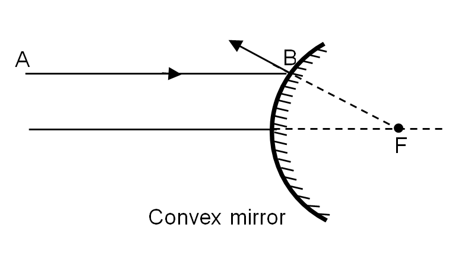
What is a convex mirror?
A.) Curved or bowed outward like outside of a bowl or sphere
B.) Curved like inner surface of a bowl or sphere
C.) Curved inward
D.) None
Answer
498k+ views
Hint: Recall the differences between convex and concave mirrors in which the reflective surface bulged outward and in which it is recessed inward.
Complete step by step answer:
The convex mirror has a reflecting surface that curves outward resembling a portion of the outside of a ball or sphere.
Light rays parallel to the optical axis are reflected from the surface in a manner that diverges from the focal point, which is behind the mirror.
Images formed with convex mirrors are always right side up and reduced in size. These images are also termed virtual images, because they occur where reflected rays appear to diverge from a focal point behind the mirror.
Hence, the correct option is A, i.e., Curved or bowed outward like outside of a bowl or sphere.

Additional Information:
The mirror whose reflecting surface is flat is a plane mirror whereas a mirror with the curved reflecting surface is termed as a spherical mirror. A spherical mirror is of two types, i.e. convex mirror and a concave mirror. A convex mirror has a reflecting surface that bulges outside.
On the contrary, in a concave mirror, the reflecting surface bulges inwards.
The main difference between a convex and concave mirror lies in the image formed by the two mirrors, i.e. while convex mirror forms diminished image, the concave mirror either forms an enlarged image or a diminished one, depending upon the position of the object.
Convex mirrors are often used in automobile right-hand rear-view applications where the outward mirror curvature produces a smaller, more panoramic view of events occurring behind the vehicle.
Note: Students should understand the differences between the reflecting surfaces of convex and concave mirrors and so that they do not confuse between these types of curved mirrors. If students relate the concept of curved mirrors with the examples of daily life then it will be very easy to remember.
Complete step by step answer:
The convex mirror has a reflecting surface that curves outward resembling a portion of the outside of a ball or sphere.
Light rays parallel to the optical axis are reflected from the surface in a manner that diverges from the focal point, which is behind the mirror.
Images formed with convex mirrors are always right side up and reduced in size. These images are also termed virtual images, because they occur where reflected rays appear to diverge from a focal point behind the mirror.
Hence, the correct option is A, i.e., Curved or bowed outward like outside of a bowl or sphere.

Additional Information:
The mirror whose reflecting surface is flat is a plane mirror whereas a mirror with the curved reflecting surface is termed as a spherical mirror. A spherical mirror is of two types, i.e. convex mirror and a concave mirror. A convex mirror has a reflecting surface that bulges outside.
On the contrary, in a concave mirror, the reflecting surface bulges inwards.
The main difference between a convex and concave mirror lies in the image formed by the two mirrors, i.e. while convex mirror forms diminished image, the concave mirror either forms an enlarged image or a diminished one, depending upon the position of the object.
Convex mirrors are often used in automobile right-hand rear-view applications where the outward mirror curvature produces a smaller, more panoramic view of events occurring behind the vehicle.
Note: Students should understand the differences between the reflecting surfaces of convex and concave mirrors and so that they do not confuse between these types of curved mirrors. If students relate the concept of curved mirrors with the examples of daily life then it will be very easy to remember.
Recently Updated Pages
What percentage of the area in India is covered by class 10 social science CBSE

The area of a 6m wide road outside a garden in all class 10 maths CBSE

What is the electric flux through a cube of side 1 class 10 physics CBSE

If one root of x2 x k 0 maybe the square of the other class 10 maths CBSE

The radius and height of a cylinder are in the ratio class 10 maths CBSE

An almirah is sold for 5400 Rs after allowing a discount class 10 maths CBSE

Trending doubts
The Equation xxx + 2 is Satisfied when x is Equal to Class 10 Maths

Why is there a time difference of about 5 hours between class 10 social science CBSE

Change the following sentences into negative and interrogative class 10 english CBSE

Write a letter to the principal requesting him to grant class 10 english CBSE

Explain the Treaty of Vienna of 1815 class 10 social science CBSE

Write an application to the principal requesting five class 10 english CBSE




